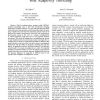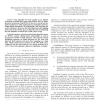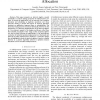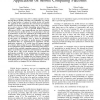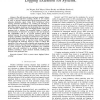SAMOS
2015
Springer
9 years 1 months ago
2015
Springer
—Today’s multi-processor system-on-chip (MPSoC) systems increasingly have to deal with dynamically changing application workload scenarios. To cope with such dynamic applicatio...
SAMOS
2015
Springer
9 years 1 months ago
2015
Springer
—Task migration has been applied as an efficient mechanism to handle faulty processing elements (PEs) in Multiprocessor Systems-on-Chip (MPSoCs). However, current task migration...
SAMOS
2015
Springer
9 years 1 months ago
2015
Springer
—After their success in the high performance and desktop market, Graphic Processing Units (GPUs), that can be used for general purpose computing are introduced for embedded syste...
SAMOS
2015
Springer
9 years 1 months ago
2015
Springer
Abstract—The ever-increasing complexity of advanced highresolution image processing applications requires innovative solutions to ensure addressing this issue efficiently and co...
SAMOS
2015
Springer
9 years 1 months ago
2015
Springer
—This paper presents an interval algebra created specifically to evaluate timing properties of multiprocessor systems. It models the application load as intervals, and considers...
SAMOS
2015
Springer
9 years 1 months ago
2015
Springer
—The AXIOM project (Agile, eXtensible, fast I/O Module) aims at researching new software/hardware architectures for the future Cyber-Physical Systems (CPSs). These systems are ex...
SAMOS
2015
Springer
9 years 1 months ago
2015
Springer
—As systems continue to evolve they rely less on human decision-making and more on computational intelligence. This trend in conjunction to the available technologies for providi...
SAMOS
2015
Springer
9 years 1 months ago
2015
Springer
—Computer vision (CV) is widely expected to be the next big thing in mobile computing. The availability of a camera and a large number of sensors in mobile devices will enable CV...
SAMOS
2015
Springer
9 years 1 months ago
2015
Springer
Abstract—In this work, we introduce an application autotuning framework to dynamically adapt applications in multicore architectures. In particular, the framework exploits design...
SAMOS
2015
Springer
9 years 1 months ago
2015
Springer
Abstract—The shift towards more and more complex Systemon-Chips fosters high-level modeling (HLM) of new systems in order to provide required time-to-first-virtual-prototype and...
